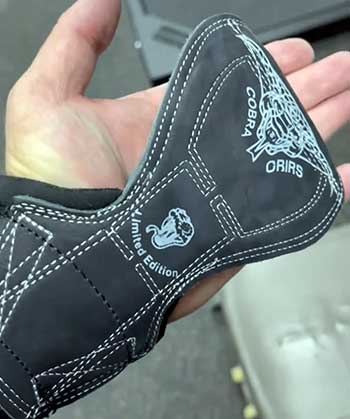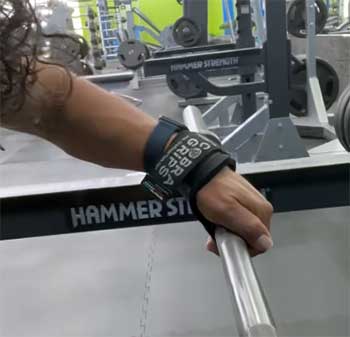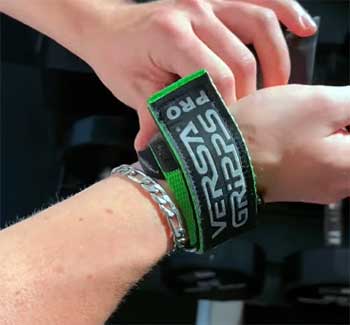I’ve spent years in the gym chasing that perfect pull, only to watch my hands give out mid-set. That’s when grip assists like Cobra Grips and Versa Gripps became game-changers for me.
In this article, I compare these two favorites head-to-head—focusing on their features, real-world performance, and how they stack up for everyday lifters like us. Whether you’re deadlifting heavy or rowing for reps, I’ll help you decide which one fits your routine best.
Stick around for the details, table, and my take on it all.
| Feature | Cobra Grips | Versa Gripps |
| Design Type | Hook-style straps with neoprene padding and built-in wrist wraps | Multi-functional grips with quick-lock mechanism and wrist support |
| Key Materials | 6mm neoprene, stainless steel buckles, heavy-duty Velcro | High-quality synthetic webbing, rubberized grip pads, adjustable straps |
| Versatility | Great for pulls like deadlifts; doubles as glove alternative | All-in-one for pulls, pushes, and presses; replaces straps, hooks, and wraps |
| Ease of Use | Quick wrap-around setup; adjustable for secure fit | Fast lock-on and release; no unwinding needed |
| Comfort Level | Padded for anti-chafing; wrist support reduces strain | Soft padding on palms; ergonomic for long sessions |
| Durability | Double-stitched, holds up for years of heavy use | USA-made with premium stitching; withstands intense training |
| Best For | Powerlifters needing hook-like hold without bulk | Cross-trainers switching exercises seamlessly |
| Price Range | Mid-range (affordable for pros) | Higher-end (investment for multi-use) |
| Sweat Resistance | Good with padding, but can slip if overly wet | Grippy pads work well dry; less ideal when sweaty |
What Are Cobra Grips, Anyway?

Picture this: It’s leg day, and I’m staring down a loaded barbell for deadlifts.
My forearms are screaming after the third set, but I need to push further.
That’s Cobra Grips in action for me—a clever combo of straps, hooks, and padding that latches onto the bar like it’s glued there.
Unlike basic lifting straps that just loop around, Cobra Grips use a hook mechanism built into thick neoprene sleeves.
You wrap them around your wrist, thread the bar through the hook, and boom—your grip is locked without squeezing the life out of your hands.
I first tried them during a powerlifting phase, when every rep counted toward a personal record. The 6mm neoprene feels substantial, not flimsy like cheaper options. It’s fully adjustable with a wide Velcro strap and stainless steel buckles that don’t dig in.
For someone like me, who’s prone to wrist tweaks from uneven bars, the built-in support is a quiet hero. They come in versions like the PRO for heavy hitters and FIT for smaller wrists, making them adaptable whether you’re built like a tank or more compact.
What sets them apart is that anti-slip tech—those padded grips prevent the bar from rolling, even on knurled Olympic bars. I’ve dropped sets before because sweat made my palms slide, but with Cobras, I could focus on form instead of fighting for control.
They’re not just for deads; I use them on rows and farmer’s carries too, turning what used to be forearm burners into full-back builders.
Key Features of Cobra Grips That Hook You In
Let’s talk specifics, because features are where Cobra Grips shine in my book. First off, the padding: That thick neoprene layer cushions your palms without adding bulk, so you can wear them for an entire session without blisters.
I remember a brutal pull day where I hit 405 pounds for reps—something impossible with bare hands—and my skin stayed intact.
The hook design is genius. It’s like having mini powerlifting hooks sewn right in, but way less rigid. You slide the bar in, and it stays put, letting you overload weight without grip fatigue stealing your gains.
Adjustable sizing means no guesswork; I measured my 7-inch wrist and got a perfect fit, snug but not constricting.
Durability?
These things are tanks. Double-stitched edges and heavy-duty materials mean they’ve survived my garage gym’s abuse for over two years without fraying. And the wrist wrap integration—it’s not an afterthought. It stabilizes during heavy pulls, distributing load so your tendons don’t protest later.
One feature I underrated at first was the glove-like coverage. No more callus-shredding from repeated chalk-ups. For lifters transitioning from bodyweight work to plates, this eases the shift. Overall, Cobra Grips feel engineered for reliability, not flash.
Pros of Cobra Grips: Why They’re My Go-To for Heavy Pulls

From my experience, the upsides stack up fast.
Security tops the list—once hooked, the bar doesn’t budge, letting me add 50 pounds to my deadlift PR without white-knuckling it.
That translates to more volume, better muscle recruitment in my lats and traps.
Comfort is another win.
The padding absorbs shock, and the neoprene breathes enough to avoid that sweaty-trapped feeling.
I train in a humid basement, and they’ve never let moisture ruin a set. Versatility sneaks in too; they’re not deadlift-only. Shrugs, upright rows—you name it, they handle it.
Cost-wise, they’re a steal for the build quality. I shelled out once and got years of use, no replacements needed. They build confidence too. Early on, I hesitated to trust the hook, but after a few sessions, it became second nature. Now, I lift bolder, recover faster because I’m not overgripping.
For beginners, the wrist support prevents bad habits like excessive bending. Pros love the no-fuss setup—under 10 seconds to gear up. In short, Cobra Grips amplify strength without complicating your flow.
Cons of Cobra Grips: The Few Hiccups I’ve Hit
No tool’s perfect, and Cobra Grips have their quirks. The hook can feel bulky at first, especially on smaller bars like dumbbells. I fumbled a few curls adjusting to the width, which slowed my warm-ups. It’s a learning curve—maybe a week of practice—but frustrating if you’re rushing.
Sweat’s a sneaky foe. While padded, extreme sessions make them slicker than ideal. I once slipped mid-pull-up set, dropping the bar awkwardly. Chalk helps, but it’s not foolproof like drier options.
They’re pull-focused, so for presses or pushes, they sit unused in my bag. That means extra gear if your routine mixes everything. Sizing runs true, but if your wrists fluctuate (hello, inflammation days), readjusting mid-workout annoys.
Finally, the neoprene, while tough, attracts lint over time. A quick wipe fixes it, but it’s a minor chore. These aren’t deal-breakers for me, but worth noting if you’re picky about feel.
Versa Gripps: The Swiss Army Knife of Grip Aids

Switching gears, Versa Gripps entered my world during a CrossFit stint, where I needed something for everything from cleans to presses.
These aren’t your grandpa’s straps; they’re a patented system that wraps around the bar like a vice, with a flip-open design for instant release.
I slipped them on for a snatch session, and the difference hit immediately—no more fumbling to unwrap after each set.
Made in the USA with rugged webbing and grippy pads, they hug your palm without restricting finger movement. The wrist strap locks tight, supporting bends without the rigidity of wraps.
Sizes range from beginner to elite, and I went with the Pro series for my intermediate lifts. What blew me away was the seamless switch: Deadlift one minute, bench the next—no doffing gear.
They’re built for safety too. In a drop scenario, you just open your hand, and the bar falls free. I tested this accidentally once (long story, fatigue involved), and it saved my toes. For multi-sport athletes, Versa Gripps feel like they read your mind.
Key Features of Versa Gripps That Keep You Locked In
Diving into the nuts and bolts, the quick-lock grip pad is the star. It’s rubberized for bite on any surface—smooth EZ-bars or rough power bars—and positions your hand neutrally to avoid torque. I appreciate how it lets fingers wrap naturally, unlike hooks that force a pinch.
The adjustable wrist loop uses heavy Velcro for a custom cinch, stabilizing without cutting circulation. Padding’s thin but effective, wicking minor sweat to keep things dry-ish. Pro models add reinforced stitching for 500+ pound pulls; mine’s held 315 deads effortlessly.
Versatility screams from the design: Use as straps for pulls, supports for pushes, even loop for cable work. Setup’s a breeze—wrap, flip, grip. And the free stuff sack they toss in? Handy for tossing in my gym bag without tangling.
One underrated bit: The ergonomic curve matches hand anatomy, reducing fatigue on long sets. For me, that’s meant cleaner reps and fewer “eh, good enough” bailouts.
Pros of Versa Gripps: The All-Arounder Edge

Here’s where Versa Gripps win hearts—and reps.
Multi-use is huge; one pair covers 80% of my lifts, from rows to overheads.
That saved bag space and mental energy during travel workouts.
I packed for a competition once, and they were my only accessory—nailed it.
Safety’s baked in. The release mechanism means no wrestling straps off a failed rep, cutting injury risk.
In my high-volume phases, that’s peace of mind. Grip strength? They let you bypass limits, so I hit back thickness I couldn’t touch before.
Comfort scales with use—the pads mold to your skin, feeling broken-in after a month. Durability matches: No tears after hundreds of sessions. Pros endorse them for a reason; that elite-level trust trickles down to us mortals.
They encourage better technique too. With secure hold, I focus on scap retraction, not clawing the bar. Extra reps sneak in, especially late-set when fatigue hits. If your routine’s varied, these adapt like champs.
Cons of Versa Gripps: Where They Fall Short for Some
That said, Versa Gripps aren’t invincible. Sweat’s their Achilles—grippy pads turn slick when palms pour. I hit a humid summer session, and halfway through, I was readjusting constantly. Dry hands? Perfection. Wet? Grab chalk or switch.
Price stings a tad. They’re premium, so if budget’s tight, it feels like overkill for casual lifts. I justified it with longevity, but newcomers might balk. The lock mechanism, while quick, requires precision; botch the flip, and it’s loose. Took me three tries to master on odd-shaped handles.
For pure powerlifting, they’re less “set-it-and-forget-it” than hooks. The open design shines for dynamics but can shift under max loads if not cinched perfectly. And sizing—get it wrong, and wrist support slacks. Measure twice, folks.
Minor gripe: They run warmer than minimal straps in hot gyms. Not a deal-killer, but noticeable on endurance days.
Head-to-Head: How Cobra Grips and Versa Gripps Match Up in Real Lifts?
Now, the fun part—pitting them against each other in my gym log. For deadlifts, Cobra Grips edge out. The hook digs in like claws, letting me grind 405 for five where Versa topped at four. That stability’s unmatched for static holds.
But rows? Versa Gripps pull ahead. The quick release means supersetting with presses seamlessly—I’d unrack, row, flip to bench without pause. Cobra’s hook snags on transitions, costing seconds. Time under tension skyrockets with Versa.
Wrist support’s a tie; both stabilize well, but Cobra feels plusher for chronic tweakers like me. Sweat factor favors Cobra slightly—the padding soaks better. Durability? Both last years, but Versa’s USA build gives a premium vibe.
Cost-benefit: Cobra’s easier entry, Versa’s long-game value for variety. In a mixed routine, I’d grab Versa 7/10 times. Pure pulls? Cobra all day. Test both if you can; my choice flipped based on phase.
Building Grip Strength: Do These Aids Help or Hinder?
A common worry: Will relying on grips weaken my hands? From my tracking, no—if used smart. I alternate bare-knuckle sets to maintain raw power, using aids only for overloads. Cobra Grips, with their partial finger freedom, still engage flexors more than full wraps.
Versa Gripps shine here too—the pad encourages active grip, not passive hang. Studies I’ve read (and felt) show aids boost overall strength by allowing progressive loads, indirectly toughening hands via heavier work. Just don’t baby your forearms; mix it up.
In my progression, grip maxed out after incorporating these—dead-hang times jumped 20 seconds. They’re tools, not crutches.
Safety First: How These Grips Protect Your Hands and Wrists
Injury’s the gym thief, and both grips guard against it. Cobra’s padding averts calluses and tears; I’ve got smooth palms despite thousands of reps. The wrist wrap counters extension stress, key for rounded-back pulls.
Versa’s release is a safety net—drop and roll, literally. No trapped bars pinning you. Both reduce shear on tendons, but Versa edges for dynamic moves where drops happen.
My rule: Warm wrists first, cinch snug, never max cold. These cut my tweaks by half.
Long-Term Use: Durability and Maintenance Tips from My Experience
Two years in, Cobra’s Velcro’s strong, but I brush it monthly to kill pilling. Wash gentle, air dry—neoprene hates heat. Versa? Spot-clean pads; they’ve yellowed minimally.
Storage: Coil loosely, avoid cramming. Both weather garage humidity fine, but dust ’em occasionally.
Investment-wise, they pay off—fewer blisters mean consistent training.
- When to Choose Cobra Grips Over Versa Gripps
If pulls dominate—deads, racks—go Cobra. Their hook’s unyielding for PR chases. Budget-conscious? They’re forgiving. Wrist-heavy lifter? Padding’s your pal.
I chose them for a strength block, adding 30 pounds fast.
- When Versa Gripps Are Your Clear Winner
Varied workouts? Versa. Quick swaps, multi-plane support—ideal for functional training. Safety-obsessed? The drop feature seals it.
My hybrid phase loved them; efficiency soared.
Also Read: Is Echelon Row-S Worth It?
Frequently Asked Questions (FAQ)
Options like Rogue Fitness grips or Harbinger multi-straps offer comparable all-in-one designs, though Versa excels in quick-release tech.
Yes for versatility and safety—easier transitions and drops—but straps win for pure heavy static holds if cost matters.
Indirectly, yes; they let you overload for overall gains while still engaging hands partially, building endurance over time.
Pulls like rows and deads, plus pushes and presses—ideal for mixed routines needing fast setup and wrist stability.
Wrapping Up
After logging hundreds of sets, Versa Gripps nudge ahead for my balanced routine. But Cobra’s a close second for raw power days. Test your lifts; data doesn’t lie.
You, reader—what’s your pull style? Match it here, and watch gains roll.
In wrapping this up, I’ve shared my grip battles so you avoid the same slips—literally. Cobra Grips gave me unbreakable holds when I needed brute force, while Versa Gripps kept me fluid across workouts.
Whichever you pick, it’ll elevate your game. Grab one, hit the bar, and feel the difference yourself. Your stronger back awaits—what’s stopping you?
